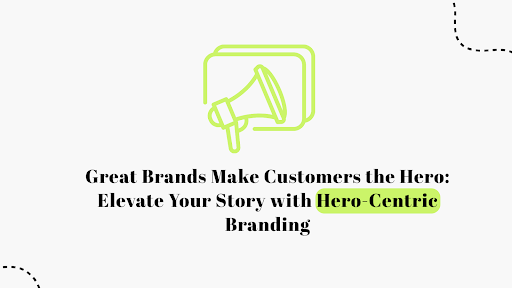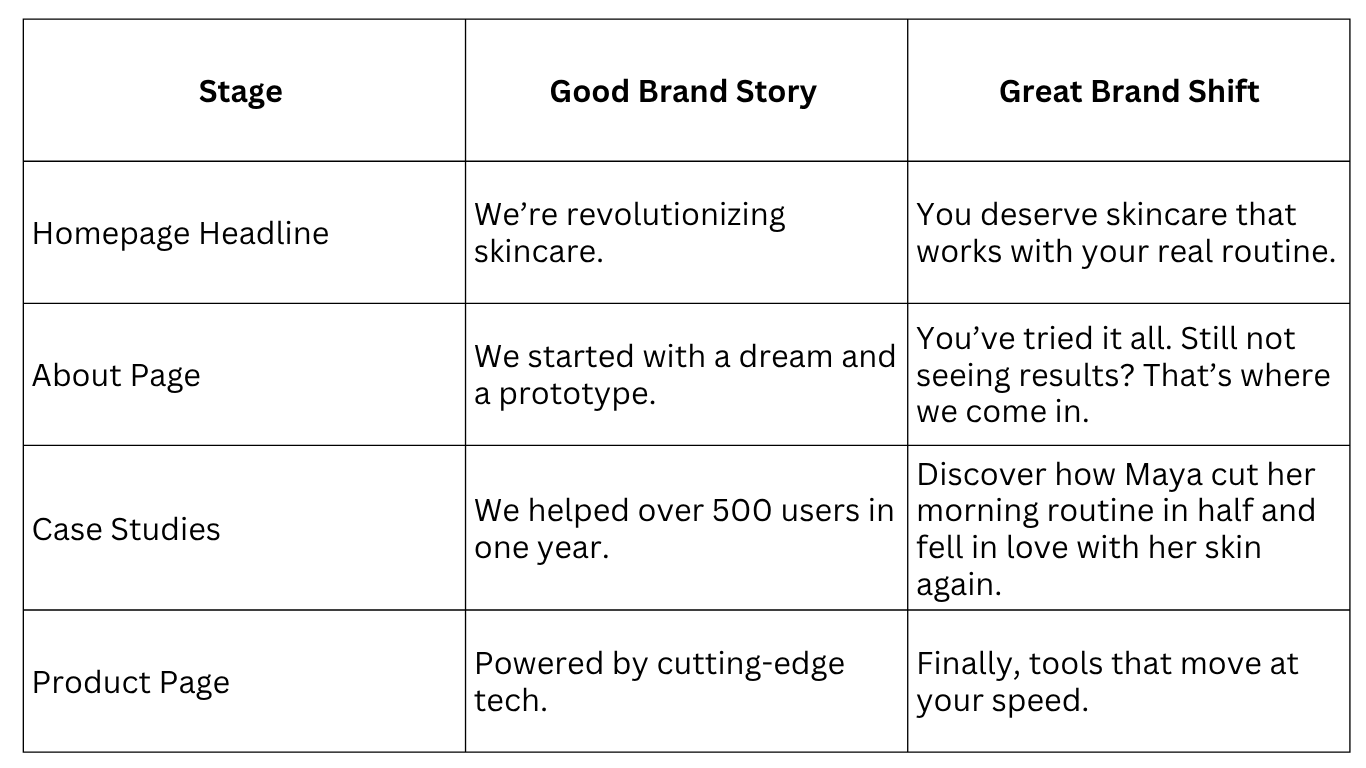



Everything
is almost
here
All
the new
Collection
Everything
is almost
here
All
the new
Collection

When you work with founders, especially through Top Branding Agencies for CEOs, you often hear them focus on telling their brand story. But they forget that storytelling isn’t the goal—connection is. Connection doesn’t come from brands talking about themselves. It comes from making your customer feel seen, understood, and empowered. That’s the quiet difference between good brands and great ones. Good brands tell stories. Great brands make the customer the hero.
Let’s explain what that means and how startups can create a brand that not only communicates but also lasts.
In 2014, having a brand story may have made you stand out, but today the scenario is different. It’s table stakes. Everyone has a story. Most sound the same. We launched, we struggled, and we found product-market fit. We’re mission-driven. We care. We’re different. But your customer is busy. Distracted. Bombarded with brands every day claiming to care. What makes you stand out isn’t your story. It’s what your story helps them believe about themselves. Customers don’t remember the brand that talked the most. They remember the one that made them feel something, which is Hope. Confidence. Clarity. A path forward. That’s the unlock. If your story puts them at the centre, if it positions them as the person with the possibility and you as the one who gets them there, then you've stopped marketing.
You launched your business because you saw a difference. Solved a problem. Believed in something better. That’s powerful. But it’s not the story your audience needs to hear first. Many early-stage brands fall into the “founder as hero” trap, crafting narratives about their hustle, their idea, and their breakthrough. It feels personal. It feels real. But it misses the mark.
Here’s why:
The shift: From “Look what we’ve built” to “Here’s how we help you win.”
Let's break the myth before it questions you. It's a direct approach that you have to get the fundamentals is that you are not the star here, you are the guide and once you fully understand that, your entire brand narrative transforms.
Let me take you through a thought, for example, think of a story that always lingers in the mind of the audience or the one that touches the audience. There’s always a hero (your customer), and you’re the guide who helps them reach their position. I would rather say that this is not just an analogy; it is a brand-building framework because it works through human psychology. We relate to stories that parallel our struggles, roles, and growth. The catch is when your customer sees their problem reflected in your brand, then you have their attention, and in that moment, everything shifts with a gear because, when they believe you are going to help them overcome it, you have their trust.
When your customer wins, your brand becomes unforgettable because you weren't the centre; you were the true guide for them. The one who helped them gain that recognition they had always wanted to see, and this story deserves to be told.
This is what a feel-good marketing strategy looks like. It’s a conversion-driven approach.
Here’s what shifts when you stop spotlighting your brand and start elevating your customer:
When you talk less about yourself and more about what your audience needs, your copy stops sounding like marketing and starts sounding like relevance.
People engage with brands that reflect them. When your visuals, words, and experiences are built around their transformation, they show up more.
You’re not pushing. You’re partnering. When a brand consistently says, “We see you,” it earns more than attention; it earns loyalty.
Customers don’t buy the best product. They take the clearest path to their desired outcome. When your brand makes that journey obvious, conversion becomes frictionless.
Let’s visualize how a startup can evolve its storytelling with this lens.

Words matter. But design does the heavy lifting when it comes to emotional resonance. A hero-centric brand doesn’t just say the customer is the star; it shows it.
Your visual identity should make your audience feel like they’re already on the journey.
Let's get practical. You've rethought your brand story. You've recentered the customer. Now you need a platform that brings it all to life, a variation which will seamlessly combine fluidly, beautifully, and fast. That's where Webflow comes in. It's not just a design tool. It's a brand expression engine. One that gives power back to founders and creative teams looking for full control without relying on full code.
Why it works:
Total Design Freedom
We're not discussing ready-made templates or those confusing websites that overwhelm you with cookie choices. Webflow stands out from the rest. It lets you design experiences that show your customer's journey, step by step. You can create pages that feel like personalized journeys, not generic landing zones. Want to highlight a mid-scroll success story? Or visualize a before-and-after? With Webflow, it's not only possible but intuitive.
Personalized Interactions
Hero-centric brands don't just inform, they also immerse. Use scroll-based storytelling to reveal layers of transformation as users navigate your site. Trigger animations that react to user behavior. These small micro-interactions show that we care about your experience. It's not about embellishment, it's about emotional interaction. The kind that turns a click into engagement.
Lightning-Fast Updates
Great brand stories evolve. Your site should too. Webflow allows you to test new messages, showcase customer successes, and update content instantly. You will be free from unnecessary waiting in development queues and CMS limitations. Your brand can stay agile because today's hero is looking for a brand that adapts to their pace. At Blushush, we use Webflow to create websites that aren't just beautiful, they're strategic storytelling tools. Because when the customer is the hero, every detail matters. And Webflow gives you the freedom to make everything perfect.
Ready to elevate from “good” to “great”? Run your brand through this checklist to make sure your customer is always the star.
This isn’t about box-ticking. It’s about building a brand that feels like home to the people you serve.
It’s not easy to pull yourself out of the centre of your own story. You built the thing. You sacrificed for it. You are the founder. But building a brand that lasts means moving from spotlight to strategy. From “here’s what we do” to “here’s what you’ll become.” When you get that right, your brand stops needing to convince. It simply clicks.
At Blushush, we don’t design websites that look “wow.” We design websites that scream, “You’ve got this.”
We use strategic storytelling, minimalist design, and Webflow’s full capabilities to create brand experiences where customers feel:
Final Thought: Be the Brand That Builds Belief
You don’t need to shout louder. You need to resonate deeper. If your brand is built around their success, you’ll never be ignored because everyone remembers the guide who helped them become who they always wanted to be. That’s the power of making your customer the hero, and that’s what turns a brand from “nice” to necessary. Want a Webflow site that puts your customer at the centre? Let’s build something that makes them the hero. Visually, verbally, and strategically.






.png)

